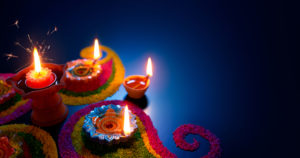
When Americans are questioned about holidays involving lights, most are likely to focus on celebrations surrounding Christmas and Chanukah. While lights definitely play a big part in both of these events, the answer would be entirely different if the question was posed to followers of Hinduism. Diwali, also known as the Festival of Lights, is a hugely important holiday that is observed each year by millions of people across the world.
Diwali is known as a “moveable holiday,” which means the exact dates of the festival change with each year. Typically, it is observed sometime between October and November. Learn a little bit more about this popular celebration and what it means by looking over some of these interesting facts.
The Return of Rama
According to statistics, there are roughly 1.08 billion practicing Hindus around the world. Since Hinduism is observed in a number of different ways, it makes sense that some of the finer details surrounding Diwali would differ from group to group. The information presented here is somewhat generic to help paint the clearest picture possible.
Diwali is a festival that lasts for five days, and according to most traditions, the official date is almost always the third day of the festival. The celebration also coincides with the Hindu New Year, and many rituals focus on this aspect.
Though the stories surrounding Diwali differ between Hindu groups, many believe the holiday is a celebration of Lord Rama. According to legend, Lord Rama and his wife, Sita, were exiled from their kingdom in India for 14 years. During their exile, they defeated a demon king known as Ravana. After killing Ravana, Rama and Sita returned to their kingdom and were greeted with a large celebration involving many lights. It is the celebration of Rama’s return that many people believe laid the foundation for Diwali.
A Festival of Lights
In the legend of Rama’s return, the people of his kingdom were so excited to see their leader return that they wanted to fill the kingdom with light. They did this by launching fireworks, lighting candles, and covering their homes with bright, shining colors. The candles are known as diyas, which play an important part in the celebration. They are placed around the perimeter of a house and at the main entrance, helping to light homes and pay homage to Rama.
While people in the modern world still use diyas during Diwali, there are other approaches that Hindus will take nowadays. Specifically, it is not uncommon to see homes decorated with rows and rows of string lights during this time of year. As with Christmas lights, it is normal to see some homes decorated with white lights and other homes decorated with an array of colors depending on the preferences of the homeowners.
New Beginnings
Since Diwali is associated with the Hindu New Year, many of the traditions and rituals surrounding it have to do with new beginnings. Many families will spend a good amount of time cleaning their homes, helping to prepare themselves for a clean slate in the coming year. Many people will also focus on charity during this time, with a very common act involving families donating food and resources to those who are in need as a way of staying in the good graces of the gods.
Though it might not be known to the average American, Diwali is one of the oldest and most celebrated holidays around the world. In fact, there is most likely a celebration happening this year somewhere near you. If you’re interested in learning more, find out where the celebrations will be held and see how you can get involved in this exciting festival of lights and life.

